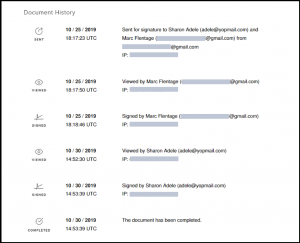

Electronic Signatures Can Be More Secure
[Disclaimer: The materials and information provided by are for informational purposes only and not for the purpose of providing legal advice. You should contact your attorney to obtain advice with respect to any particular issue or problem.]
Electronic Signatures Are Fully Recognized by the US Government
Let’s get the most important piece out of the way first. The ESIGN Act was signed into law (electronically, I might add) by President Bill Clinton on June 30th, 2000. It grants the same validity, effect, and enforceability to electronic signatures as their paper equivalents. This has been litigated and proven in court countless times and is simply not a legal question. What has become clear is that signature authenticity is often easier to prove when it originates electronically.
Signature Authentication
The electronic signature process is not the wild west. You can’t simply hop on your computer, draw your signature in Paint, and print it off. There are carefully defined rules and regulations that must be followed to validate the electronic signature process. First, the document must be encrypted and secure. Additionally, users given access must authenticate themselves and verify the email account by which they access the document.
Digital “Paper” Trail
Finally, perhaps the greatest benefit to electronic signatures (aside from the incredible convenience) is the figurative paper trail the process leaves behind. When a user signs a lease electronically, we track the email account by which they accessed it, every time they opened it, when they signed, and the IP address (physical location) from which they signed. Here’s an example of what the lease’s audit trail might look like:

Lease audit trail as proof of signature and validity. Email & IP addresses have been redacted for security.
If a tenant ever did attempt to question the validity of an electronically signed document, you would simply present this easily tracked information. In contrast, a paper document and signature is highly ambiguous. It’s impossible to know when the document was printed, delivered, or signed with any verifiable credibility. To forge a “wet signature” (as non-electronic signatures are called), all you need are competent motor controls and a few hours of practice. To forge an electronic signature, you’ll need to know when the document is generated, who’s signing, you’ll need access to password protected email accounts, and you’ll need an IP address at an appropriate location. Needless to say, it’s quite a bit easier to prove validity than forgery. eSignatures are not just a useful but risky feature; eSignatures give you the opportunity to add convenience and beef up security.




Comments